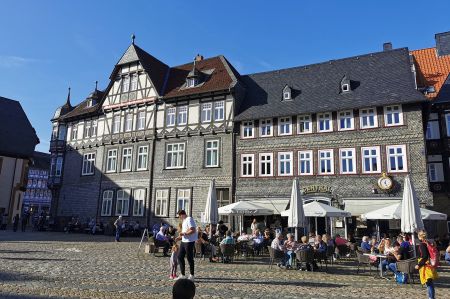Goslar - The old imperial city – a first tour
- Written by Portal Editor
Goslar - After a good 90-minute e-bike ride from the Prahljust campsite with a few photo stops along the way, we reached city centre after 22.6 kilometres. The Harz has been an important ore mining area since Roman times.
Therefore, settlements arose here in which the ore was processed and refined into metals. Archaeological finds, even from England, show that many Anglo-Saxon burial objects, such as a sword found in London, were made from the metal of the Harz ore. The earliest evidence of the mining and smelting of Rammelsberg ore could be dated to the 3rd century AD thanks to the archaeological excavations at the Düna manor.
Imperial Palace and Rammelsberg Ore Mine in Goslar
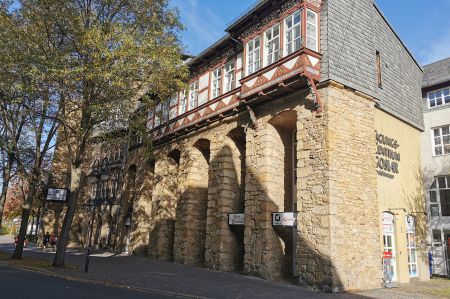 Goslar's more than thousand-year history as a medieval trading metropolis and centre of power of the German emperors is still visible in many places today.
Goslar's more than thousand-year history as a medieval trading metropolis and centre of power of the German emperors is still visible in many places today.
The magnificent imperial palace, the remains of the medieval city fortifications, numerous churches and well-preserved colorful half-timbered houses invite you to visit the past.
Since 1992, the old town of Goslar, together with the Rammelsberg ore mine, has been a UNESCO World Heritage Site, since 2010 the water supply systems of the Upper Harz Water System have also been included.
Goslar - Kaiserworth and Gothic Town Hall
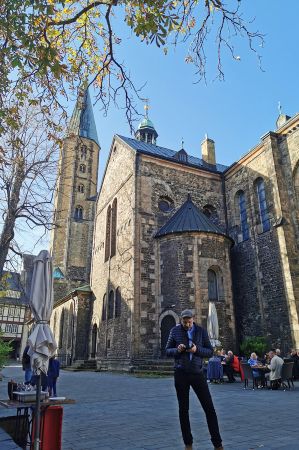 The Gothic town hall with its famous hall of homage bears witness to the great pride of the citizens, opposite, no less magnificent, the Kaiserworth, the guild hall of the tailors. The golden imperial eagle on the market fountain tells of former power.
The Gothic town hall with its famous hall of homage bears witness to the great pride of the citizens, opposite, no less magnificent, the Kaiserworth, the guild hall of the tailors. The golden imperial eagle on the market fountain tells of former power.
Through mining and a strong bourgeoisie, Goslar grew into a trading power and was even one of the founding members of the Hanseatic League. Of the nearly fifty churches, monasteries and chapels that existed in Goslar four hundred years ago, numerous are still preserved, some in ruins. Together with the remains of the city wall and the mighty wide gate at the entrance to the old town, it becomes clear to the visitor that the city also knew how to protect itself.
The Zwinger right next door, with its 6 meter thick walls, is a fortress tower straight out of a picture book. Because it is impossible to list all the sights here, a guided tour of the city is recommended for visitors.
Market square with town hall and fountain in Goslar
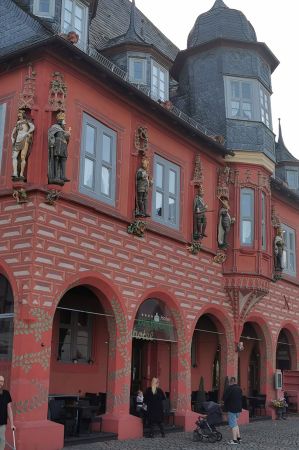 The centre of the old town is the market square with the fountain crowned by a golden eagle and the town hall.
The centre of the old town is the market square with the fountain crowned by a golden eagle and the town hall.
The building is characterized by pointed arch windows and an arcade.
Worth seeing inside is the richly decorated homage hall from the early 16th century with its colourful wooden panel paintings on the walls and ceiling. In the immediate vicinity of the town hall is the former guild hall from 1494 with its striking red façade.
The bells and puppets at the combing building, a more recent attraction, sound four times a day and demonstrate the history of mining on the Rammelsberg. A mining company donated it in 1968 on the occasion of the 1,000th anniversary of the ore mine.
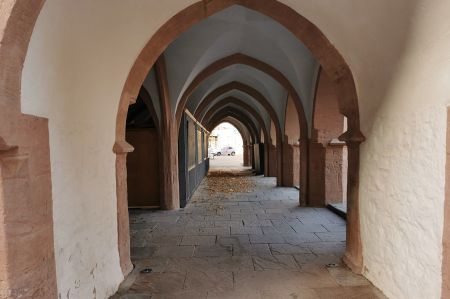 If you want to learn more about the history of Goslar, the Goslar Museum is the right place for you. In the old monastery rooms from 1514 there are extensive historical and art historical collections, including valuable pieces such as an altar from the 12th century, a gospel book from the 13th century and the original eagle from the market fountain from the 14th century.
If you want to learn more about the history of Goslar, the Goslar Museum is the right place for you. In the old monastery rooms from 1514 there are extensive historical and art historical collections, including valuable pieces such as an altar from the 12th century, a gospel book from the 13th century and the original eagle from the market fountain from the 14th century.
The tin figure museum offers a very special way of conveying history. All the important stages in the town's history are shown here in miniature - for example mining scenes, a battle in the Thirty Years' War or the great fires of the 18th century.
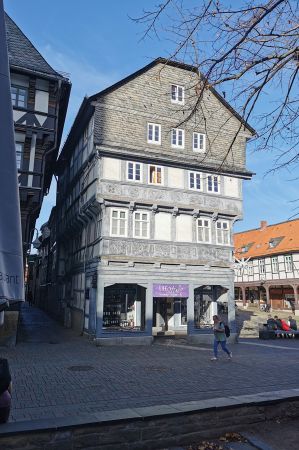 Lovers of modern art will also get their money's worth in Goslar: although the Mönchehaus is a historic building, it houses the Museum of Modern Art with an extensive collection of paintings, sculptures and installations by well-known avant-garde artists. The Kaiserring, an internationally renowned art prize, is also presented here once a year.
Lovers of modern art will also get their money's worth in Goslar: although the Mönchehaus is a historic building, it houses the Museum of Modern Art with an extensive collection of paintings, sculptures and installations by well-known avant-garde artists. The Kaiserring, an internationally renowned art prize, is also presented here once a year.
Behind the market is the market church of St. Cosmas and Damian with its two different towers. The 66 meter high north tower is accessible, which then challenges us to climb the church tower.
Goslar – The Old Town with Narrow Streets and Half-Timbered Houses – more details
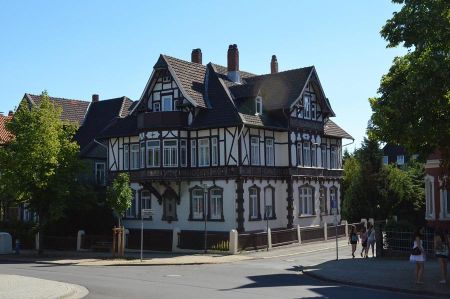 Narrow streets, lovingly restored half-timbered houses, and the scent of history in the air – welcome to Goslar, the old imperial city in the Harz Mountains. Goslar's Old Town is a true open-air museum and, not without reason, is a UNESCO World Heritage Site. A place where, among cobblestones and slate gables, you feel like you've stepped back into the Middle Ages – yet are still at the heart of the modern world.
Narrow streets, lovingly restored half-timbered houses, and the scent of history in the air – welcome to Goslar, the old imperial city in the Harz Mountains. Goslar's Old Town is a true open-air museum and, not without reason, is a UNESCO World Heritage Site. A place where, among cobblestones and slate gables, you feel like you've stepped back into the Middle Ages – yet are still at the heart of the modern world.
Where is Goslar?
Goslar is located in southeastern Lower Saxony, on the northwestern edge of the Harz Mountains. The city is easily accessible via the A7 motorway or by train and is close to cities such as Braunschweig, Hildesheim, and Hanover.
UNESCO World Heritage: Why Goslar's Old Town is Unique
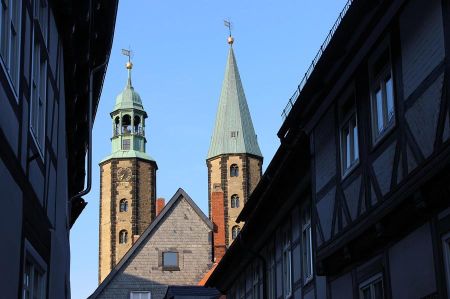 Since 1992, Goslar's Old Town, along with the nearby Rammelsberg Mine, has been a UNESCO World Heritage Site. More than 1,500 half-timbered houses from eight centuries have been preserved here – many of them inhabited or used as small shops, museums, or galleries.
Since 1992, Goslar's Old Town, along with the nearby Rammelsberg Mine, has been a UNESCO World Heritage Site. More than 1,500 half-timbered houses from eight centuries have been preserved here – many of them inhabited or used as small shops, museums, or galleries.
History meets the present – 1,000 years of culture
Goslar was once a centre of power in the Holy Roman Empire. The Imperial Palace, built in the 11th century, testifies to this importance. The old town developed over the centuries without losing its historical structure – a true window into the past.
Half-timbered art at its finest
What distinguishes Goslar is its incredible variety of half-timbered architecture.
Highlights:
- Breite Straße
• Schuhhof
• Fish Market
• Frankenberger Quarter
The most beautiful alleys of the old town
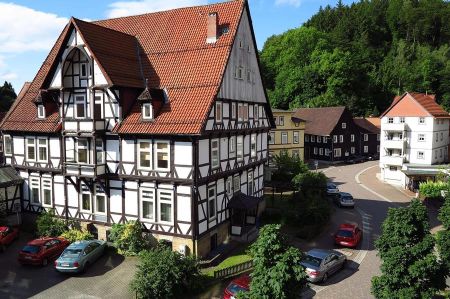 The alleys in Goslar are more than just paths – they tell stories. Narrow passageways, hidden courtyards, small squares:
The alleys in Goslar are more than just paths – they tell stories. Narrow passageways, hidden courtyards, small squares:
- Bäckerstraße: with small cafés and shops
• Rosentorstraße: picturesque and quiet
• Klapperhagen: pure historic cobblestones
• Schuhhof: one of the oldest squares in the city
Highlights in Goslar's Old Town
- Goslar Imperial Palace
• St. James' Church and Market Church
• Siemenshaus – the oldest stone building in the city
• Breite Straße – shopping in a historic atmosphere
• Tin Soldiers' Museum
The Market Square – the heart of the city
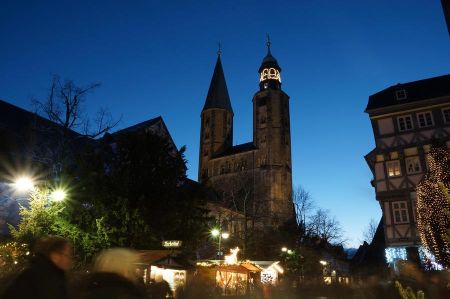 Goslar's Market Square is the vibrant centre. This is where everyone meets – tourists, locals, musicians, and artists. The historic town hall, surrounded by cafés, invites you to linger.
Goslar's Market Square is the vibrant centre. This is where everyone meets – tourists, locals, musicians, and artists. The historic town hall, surrounded by cafés, invites you to linger.
The Carillon with Miners' Procession
A special highlight is the carillon at the market square, which plays several times a day and tells the story of Goslar's mining history with moving figures – a must-see for children and adults alike.
Restaurants, Cafés, and Regional Delights
Goslar's restaurants focus on regionality:
- Harz cheese
• Game dishes from the Harz region
• Craft beer & local wines
• Traditional cafés with cakes and apple strudel
Recommendations:
- Butterhanne – regional & rustic
• Paulaner Wirtshaus – beer garden with half-timbered charm
• Café Firlefanz – stylish & cozy
Shopping and crafts among ancient walls
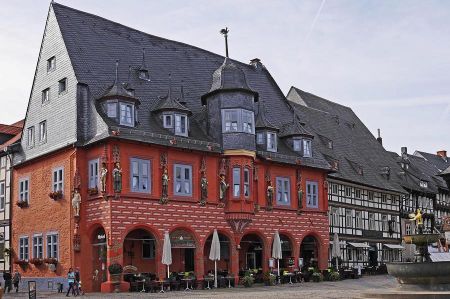 From souvenirs to ceramics to handmade jewellery – the small shops in the old town are charming and unique. Those who value quality and creativity have come to the right place.
From souvenirs to ceramics to handmade jewellery – the small shops in the old town are charming and unique. Those who value quality and creativity have come to the right place.
Events and Markets 2025
Goslar offers events throughout the year:
- Old Town Festival
• Goslar Christmas Market – one of the most beautiful in Northern Germany
• Kaiserring Awards Ceremony – a renowned art event
• Summer Crafts Market
Stay overnight in historic buildings
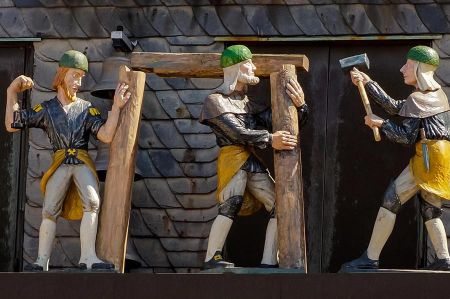 Many hotels and guesthouses are located in listed buildings
Many hotels and guesthouses are located in listed buildings
Recommendations:
- Hotel Kaiserworth
• Guesthouse Schiefer
• Old Town Apartments Goslar
Tips for photographers and architecture fans
- Early morning stroll through the empty alleys
• Look up – many details are above eye level
• The blue hour on the market square
• Visit the Imperial Palace with sunlight streaming through arched windows
Conclusion: Why a visit to Goslar is worthwhile
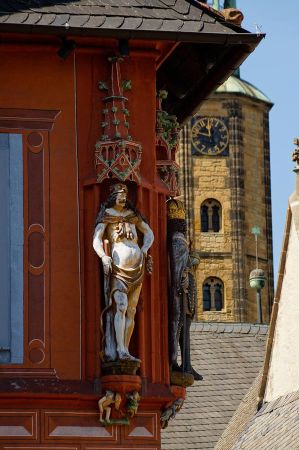 Goslar is a place for connoisseurs, history buffs, and strollers. The old town tells of craftsmanship, power, faith, and everyday life – embedded in an enchanting setting. Anyone who has strolled through Goslar's alleys once will want to return.
Goslar is a place for connoisseurs, history buffs, and strollers. The old town tells of craftsmanship, power, faith, and everyday life – embedded in an enchanting setting. Anyone who has strolled through Goslar's alleys once will want to return.
Frequently Asked Questions (FAQs)
1.Is Goslar suitable for a day trip?
Yes, all major attractions are within walking distance.
2. Is there parking in the old town?
Parking garages and public parking spaces are available near the city centre.
3. Can I book guided tours?
Yes, historical city tours and themed tours are offered.
4. Is the old town wheelchair accessible?
Partially – many paths are paved, but there are alternative routes.
5. What is the best time of year to visit?
Spring, autumn, and the Christmas season are particularly atmospheric.
But more on that in the next article.
Please read as well:
